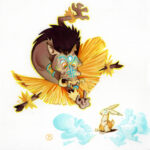Summary: I randomly selected the book, “RGK, The Art of Roy G. Krenkel” off of my shelves of inspiration to do a book review. Along with a brief overview of the book’s contents there are some of my opinions about aesthetics in fantasy art.
I should start this blog post by stating what I hope is obvious; I am a huge fan of books and not surprisingly, a huge fan of illustration. So it should come as no surprise that when it comes to combining two of my favorite things, I turn into a slobbering geek. As a result of this particular fascination, I enjoy reading and collecting books on or about illustration and illustrators. With that in mind, I’d like to turn our attention to subject of this post which is a book that I very much enjoy, “RGK, The Art of Roy G. Krenkel.”
A brief overview
I purchased this book in 2010, and unlike many of my other art books, I actually read through all the wordy bits of this generously illustrated book. What emerges to me from the writing is a portrait of a man who was beloved by many, who seemingly always had a kind word to say and was perhaps a slightly mischievous fellow. But it is his work that states clearly that he enjoyed delving deeply into the world of the fantastic. He is also shown to be something of an interesting transitional figure in the history of fantasy art. He wore his historical influences close to the surface of his work, while still remaining original. He worked on fantasy book covers just prior to the lightning rod that was Frank Frazetta and after luminaries like James Allen St. Johns and Franklin Booth. His work added to aesthetics of early EC Comics, and built upon the tradition of pen and ink drawings from the likes of Joseph Clement Coll and Franklin Booth. His biography is told through the recounting of many of his friends, which include the likes of Al Williamson, Frank Frazetta, William Stout, and Michael Wm. Kaluta, just to name a few. They tell us about Roy’s own fascination with art and illustration, and even something about his internal relationship to his work and his influences. The book chronicles his artistic growth from the days of collaboration on EC comics from the 50’s, to his own career doing iconic fantasy book covers for titles by Edgar Rice Boroughs, and Robert E. Howard.
Pretty Pictures
I was personally excited to see the reproductions of his watercolors in the book. The prints are of a good quality and one can even see where Krenkel applied colored pencil on top of his paints! (I know, exciting nerd moment there.) While the paintings are wonderful to look at, his work derives the bulk of its strength from his draftsmanship. His drawings are solid and imaginative. His passion for drawing is made clear by the numerous tissue paper sketches and personal drawings that are included in the book. The publisher has also chosen to show an array of wonderfully considered color studies both in full page size, and at actual postage stamp size, glee! I think that from viewing the initial drawings, through to the color comps and compositional sketches, Roy’s method of working is fairly laid bare to see. As an added bonus there are even a few sketches which are include that have Krenkel’s own personal notations about color and light off in the margins of the thumbnails.
Wabi Sabi
In all, Roy G. Krenkel’s work shows a different time and era of Fantasy and Science Fiction art, one which allowed room for some “imperfections.” And, I’ll freely admit that “imperfections” isn’t really the right word here, but I can’t think of a better one, perhaps it is more akin to the Japanese aesthetic of Wabi Sabi. For me, seeing the presence of the artist’s hand in the work and the personal nature of the drawings, allow access to that certain childlike fascination and wonder that resides in the golden memories of our youth. This is a point that I have difficulty expressing, but it is a similar sensation to the joy that I get from watching the original Godzilla movies, or the stop motion animation by Ray Harryhausen in Jason and the Argonauts, or The Dark Chrystal. I believe that this quality allows the viewer to become something of a willing accomplice in the suspension of disbelief in the work. This is an aesthetic that seems to run contrary to some popular forms of fantasy art today. While I enjoy photo-realistic images, I find that the images where the artist can be seen in the creation are more charming and elicit more of an emotional connection for me. This is, of course, all a matter of taste and preference.
Conclusion:
I hope that it’s fairly clear that I enjoy looking at this book, and that I find a lot of inspiration here as well. Whether it’s seeing how Krenkel embodied his influences, or in the more practical endeavor of seeing another artists process, there seem to a number of fascinating offshoots from this book that help to broaden one’s horizons. And, in the end, it is just chock full of great pictures to look at, and if you can derive pleasure and even inspiration from that, well then this book might be worth your time.
As ever, your comments are welcome here. What do you think about seeing the hand of the artist, is it worth it or not?
If you’d like more information, here are a couple of quick links to get you started out there on the interwebs:
• Vanguard Publishing where you can purchase the book
• BudPlant Bio of Roy G. Krenkel
• A whole boatload of posts containing Krenkel from the Golden Age Comic Book Stories blog





[…] contents there are some of my opinions about aesthetics in fantasy art.Read more about… Book Review and Inspiration TweetCats: Editor's Choice, Fine Art, Illustration, Publishing Tags: art, fantasy, Publishing, […]